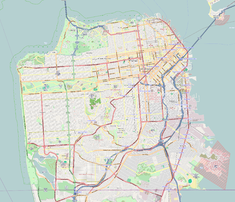|
Cadillac Hotel (San Francisco, California)
The Cadillac Hotel is a historic building from c. 1907 – c. 1908 in the Tenderloin neighborhood of San Francisco, California, U.S.. It was the first non-profit single-residence occupancy (SRO) hotel in the Western United States.[1] Since 2015, the first two floors of the building is the home to the Tenderloin Museum, a cultural history museum dedicated to the neighborhood.[2][3][4] It was called the A.A. Louderback Building, and nicknamed "The House of Welcome" during the early 20th-century.[5] The Cadillac Hotel has been listed as a San Francisco Designated Landmark since 1985;[6][7] and is part of the NRHP-listed Uptown Tenderloin Historic District since 2009.[8] The building also has a historical marker, erected by Uptown Tenderloin, Inc.[9] HistoryThe Cadillac Hotel was designed by architectural firm, Meyer and O'Brien (Frederick Herman Meyer and Michael Smith O'Brien) as a hotel for client Andrew A. Louderback (1831–1926).[6][10] It is a four-story steel beam building with reinforced brick, with a three-part design in a Renaissance Revival/Baroque Revival architectural style with the influence of Art Nouveau.[1][11] In the early 19th-century, the building had 180 guest rooms, a ballroom, and the first floor had many retail stores.[12] It was built right after the 1906 San Francisco earthquake and fire.[11] It pre-dated the majority of the residential building in the Tenderloin neighborhood, which occurred years later around the opening of the Panama–Pacific International Exposition of 1915.[6] From 1924 until 1992, the Cadillac Hotel housed the Newman's Gym, founded by Billy Newman.[1] It was noted for being one of the oldest boxing facility in the country, and the practice space for Muhammad Ali, Joe Louis, Jack Dempsey, George Foreman, and Sugar Ray Robinson.[1] In the 1960s, businessman Donald Fisher owned the building, and stripped away many of the historical details from the architecture.[12] In the 1970s and 1980s, single-residence occupancy (SRO) and tenant rights activism grew, along with a desire to preserve the Tenderloin. Community activist Leroy Looper and Reality House West purchased the building in 1979, with the goal of creating housing for the homeless.[1] Lopper rehabilitated the Cadillac Hotel building through the help of various grants, and housed some 160 tenants.[1] In 2015, Tenderloin Museum (formerly Tenderloin History Museum) moved into the ground floor of the building.[12] The Cadillac operates as a "shelter plus care hotel" in modern-day.[12] In 2023, the building made the news with the elevator breaking many times a year, and trapping vulnerable residents.[13][14] See alsoReferences
External links
|
||||||||||||||||||||||||


